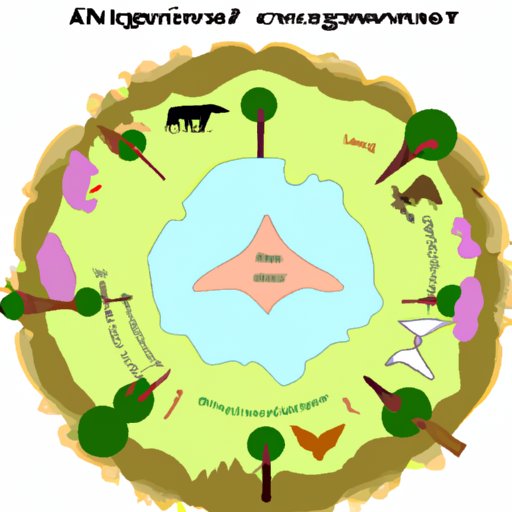Introduction
A healthy ecosystem is an environment where living organisms interact with one another and their non-living surroundings to form a balanced community. In this article, we will explore what makes a healthy ecosystem and discuss how humans can have a positive or negative impact on it.

Components of a Healthy Ecosystem
There are several essential components that make up a healthy ecosystem. These components include: interdependence of species, availability of natural resources, and biotic/abiotic factors.
Interdependence of Species
In a healthy ecosystem, species rely on one another for survival. Each species has a specific role to play in maintaining the balance of the ecosystem. For example, predators help keep prey populations in check, while herbivores help control vegetation growth. If any of these species were to become extinct, the entire ecosystem could be thrown off balance.
Role of Natural Resources
Natural resources such as water, air, soil, and sunlight are essential for a healthy ecosystem. These resources provide habitats for wildlife and plants, as well as serve as food sources for many species. Without the right balance of these resources, the ecosystem would quickly become imbalanced.
Biotic/Abiotic Factors
Biotic factors refer to the living components of an ecosystem, such as plants and animals, while abiotic factors refer to the non-living components, like temperature and precipitation. Both biotic and abiotic factors must be in balance in order for a healthy ecosystem to exist.
Human Impact on Healthy Ecosystems
Humans can have both a positive and negative impact on healthy ecosystems. The destruction of habitats due to human activities such as logging, mining, and urbanization can have devastating effects on the balance of an ecosystem. Pollution from industrial activities can also lead to the destruction of habitats and the extinction of species.
Negative Impacts on Ecosystems
The destruction of habitats and pollution of natural resources due to human activities can have serious consequences for the balance of an ecosystem. When habitats are destroyed, species may lose their food sources and be unable to survive. Pollution can also lead to the death of species by poisoning their food sources and impacting their reproduction.
Strategies for Protecting and Preserving Ecosystems
There are several strategies that can be implemented to protect and preserve healthy ecosystems. These strategies include conservation of natural resources, reforestation, and habitat restoration. Conservation of natural resources ensures that they remain available for use by wildlife and plants. Reforestation helps restore habitats that have been destroyed due to human activities. Finally, habitat restoration helps bring back species that have been lost due to habitat destruction and pollution.
Conclusion
A healthy ecosystem is one that is in balance and composed of interdependent species, natural resources, and biotic and abiotic factors. Humans can have a negative impact on the balance of an ecosystem by destroying habitats and polluting natural resources. However, there are strategies that can be implemented to protect and preserve healthy ecosystems, such as conservation of natural resources, reforestation, and habitat restoration. By taking action to protect and preserve healthy ecosystems, we can ensure that future generations will be able to enjoy them.
(Note: Is this article not meeting your expectations? Do you have knowledge or insights to share? Unlock new opportunities and expand your reach by joining our authors team. Click Registration to join us and share your expertise with our readers.)
